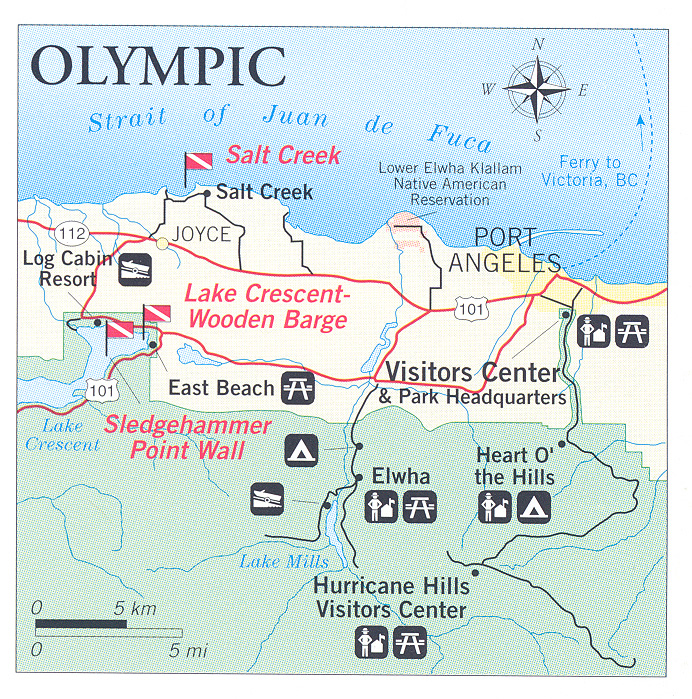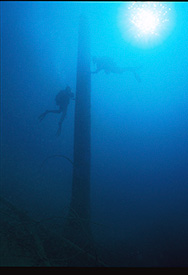Diving in Olympic National Park
The Olympic Peninsula of northern Washington state juts out like a thumb between the roiling Pacific Ocean and navigable Puget Sound, the Strait of Juan de Fuca curving around the peninsula’s northern end.
This is a place of rugged extremes-a wilderness punctured by the sheer peaks of the Olympic Mountains, graced by old growth forests, and surrounded on three sides by water. The park has two components-a narrow strip of ocean shoreline running 57 miles along the Pacific Coast from South Beach to Shi-Shi Beach; and a much larger area that takes in the vast wilderness of the Olympic Mountains and the dense forest aprons that surround them.
Many islands, rocks, and islets lie off of the coastal section of the park. Most of these are National Wildlife refuges, off-limits to visitors, but the diving around them should be nothing short of spectacular. These are so remote that very little of the underwater terrain has been explored. The waters in this area abound in marine life. Bill Dietrich, a science reporter for the Seattle Times, reports that there are more varieties of kelp, larger colonies of sea birds, and more marine mammals than in any other area in the continental United States. If that doesn't get your attention, check your pulse.
This area, rich in marine life and graveyard to many historical shipwrecks, is now designated as part of the Olympic Coast National Marine Sanctuary. The sanctuary extends from Neah Bay in the north to Copalis Beach in the south, encompassing an area about twice the size of Yosemite National Park. Within the boundaries of this area there may be more than 150 historical shipwrecks. One of these was the America, which sank in 1875 after colliding with another ship, taking almost all of her 277 passengers to the bottom.
BASICS
Location: Northwestern Washington
Skill level: Intermediate-advanced
Access: Boat for ocean dives; shore for Hood Canal; and shore or boat for Salt Creek and Lake Crescent
Dive support: Port Angeles
Best time of year: June-October
Visibility: Hood Canal, 25-30 feet; Lake Crescent, to 150 feet; Salt Creek, 15-50 feet (varies with tide)
Highlights: Marine life, shipwrecks
Concerns: Tidal currents, surge, rocky coasts, drifting logs
Rules and Regulations
Dive Site Map
Dive Overview
Diving opportunities here include some of the lakes in the interior portions, and in the waters that border non-park lands along the Strait of Juan de Fuca and the Hood Canal. The sites are abundant and information about them could easily fill an entire guidebook. We will mention a few of them and offer some guidance on where to find help in exploring others.
Dive Sites
HOOD CANAL
If you drive to the Olympic Peninsula from Seattle, taking the Bainbridge ferry across Puget Sound, you will be following the Hood Canal for part of the drive. The so-called canal is actually a natural body of water, an inland extension of the Pacific Ocean, 70 miles long, and two miles wide. The diving in the canal can be very good and, in some places, benign in terms of currents. Several good dives can be made from shore along Route 101. There are a couple of dive shops on the highway that can give you information about local dive sites. We made only one dive, near Hoodsport on an area of ledges known as the north wall. These ledges are decorated with large white-and pink-plumed anemones, and there are numerous resident wolf eels in the cracks and crevices. Lack of a strong current means that the bottom is covered in a deep fine silt. Beneath a turbid layer about 30 feet deep, the water is fairly clear with visibility of about 25 feet. This area can offer some alternatives to diving on the peninsula when the weather is bad. One of the dive shops, Hood-Sport and Dive, has a printed list of dives in the area.
SALT CREEK STATE PARK
This park is just outside the national park boundary off Highway 112 west of Port Angeles. This is a nice place to camp on the ocean and have access to some good diving as well. This area is a marine sanctuary subject to special regulations with regard to diving. The campground personnel can fill you in and we found a list of all the rules posted on the campground bulletin board. There are two easy entry points with stairs going down to the water. It is better to dive during flood tides when the water level comes up close to the bottom of the stairs so you don't have to scramble over slippery rocks to enter and exit. Once in the water you will find a rocky bottom interspersed with large boulders and crevices. The area has a nice kelp bed and a variety of marine life. The currents can become quite strong, so be mindful of this the further from shore you venture. Just off the point here is a good wreck dive on a ship named the Diamond Knot. The wreck starts in about 80 feet of water and runs down to about 140 feet. This wreck has large sections that are still intact. It is loaded with fish and completely carpeted with anemones. Because of the extremely strong currents this dive should never be attempted from shore. With enough advance notice you can arrange a charter to dive this site with Olympic Divers in Port Angeles.
OCEAN SITES
The shoreline of Olympic National Park is the longest stretch of wilderness shore in the United States and it offers world-class beachcombing and tide-pooling. As we mentioned above, Marine Sanctuary waters of the park offer the potential for some wild diving. Beach diving, however, would be hazardous at best. Local divers inform us that only boat diving is done off this coast. On a day we were there, it was flat calm, but the surf was still pounding the beach. Renegade logs that had floated down the rivers were being tossed around like pick-up sticks in the surf zone. It's frightening to contemplate what would happen to a diver hit by one of these entering or exiting the water.
LAKE CRESCENT
If you have been doing some saltwater diving along the Hood Canal and around the Olympic Peninsula, this is a great spot to rinse off in some fresh water. The water is cold, but then except at the hot springs in the park or the shower in the motel, that is the only kind of water the state of Washington offers. In addition to being cold it is also crystal-clear with visibility in excess of 150 feet. If you have a boat, places to dive are limited only by your time and energy. There are also two fine dive sites that can be accessed from land. The first shore dive site is off Highway 101 about halfway between East Beach and Lake Crescent Lodge. You will see a pull-out from the road at a place known informally as "Sledgehammer Point," a small protrusion out into the lake. Park here and begin your dive anywhere along the shore. It is a good wall dive with a sheer drop-off that goes down far deeper than you will. We limited our dive to 100 feet as we had plans to drive up to drive up to the top of Hurricane Ridge for the sunset. During one dive we noticed some rather large crayfish and some small fish that looked as if they belonged on a reef. The latter are freshwater sculpins related to the sculpin family found in the ocean.
The other site is an old wooden barge that was used to move things up and down the lake before the road was built. To reach this site, drive to the East Beach picnic area and walk around to the right as you are facing the lake just past the swimming area. Enter the water here, swim over to the dock, and begin your dive just out in front of this dock. The barge is easy to find: it starts in about 25 feet of water and continues down to slightly over 50 feet. You can do a penetration dive through the open hatches, but we don't recommend this unless you have experience diving in this type of overhead environment. (Note: The dock along with the surrounding land is a private in-holding within the park-no trespassing.)
DIVING RULES AND REGULATIONS
Diver-down flag must be displayed while divers are in the water.
The park advises checking in with a ranger if you plan to dive.
Washington State Fish & Game regulations apply.
If you are diving in the Marine Sanctuary, there may be additional rules pertaining to diving.
Last Updated: October 30, 2012










